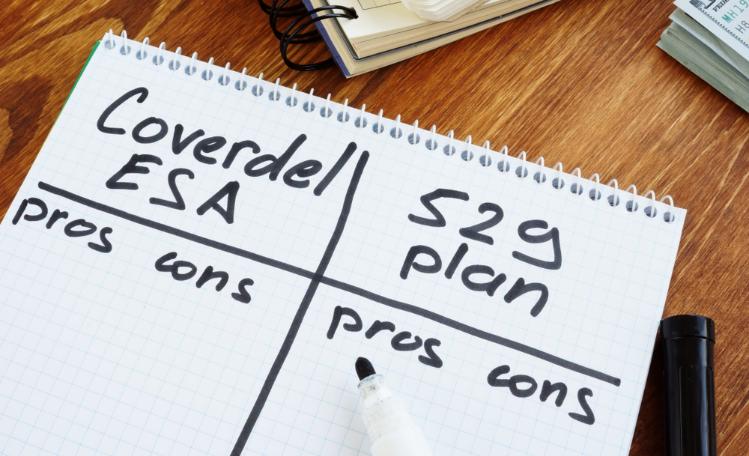With the price of education soaring in this country, it is more important than ever for parents and family members to think about saving for educational costs for their children or loved ones. The good news is that Congress has come up with two types of specific educational savings plan that can help Americans better save for education costs, including elementary, secondary, college, and even graduate school.
This article will explore the advantages and disadvantages of the Coverdell Education Savings Account (ESA) and the 529 plan. Both plans have great tax and savings benefits, but have different eligibility requirements, as well as distinct restrictions. Hence, it is important that everyone understands the power of saving for education via a Coverdell or 529 plan, and fully comprehends which plan may be the better fit.
- With education costs at an all-time high, Americans need ways to save
- Tax-advantaged accounts, such as the Coverdell ESA and 529 Plan, offers one the ability invest funds earmarked for education
- Although the plans are similar, each have their own advantages (and drawbacks)
The Coverdell ESA
A Coverdell ESA is custodial account set up solely for paying qualified education tuition and expenses for the designated beneficiary of the account. Like an IRA, the account must be set up with a bank, financial institution, or state-chartered trust company, such as IRA Financial. The savings benefit associated with a Coverdell applies not only to qualified higher education expenses, such as a university, but also to qualified elementary and secondary education expenses.
Who Can Set Up a Coverdell?
A Coverdell account can only be established by a beneficiary that is under the age of 18. In other words, the account must be established for the sole benefit of the child. Coverdell assets are not revocable. As discussed above, the Coverdell must be established by a custodian, such as IRA Financial, much like an IRA.
How Much can I Contribute to a Coverdell Annually?
The primary purpose of making contributions to a Coverdell is to help finance the beneficiary’s qualified education expenses. Contributions must be made in cash and are not tax deductible. For both 2023 and 2024, the maximum contribution amount is $2,000. There’s no limit to the number of accounts that can be established for a particular beneficiary under the age of 18, however, the total contribution to all accounts on behalf of a beneficiary in any year may not exceed $2,000.
In addition, to make an annual Coverdell contribution, one’s income must be below $110,000 for a single taxpayer and $220,000 for a married couple filing jointly. Coverdell contributions must be made by April 15.
What Investments Can I Make with a Coverdell?
A Coverdell account may be self-directed just like an IRA. Therefore, other than life insurance, collectibles, and certain transactions involving a “disqualified person” under Internal Revenue Code Section 4975, the Coverdell is permitted to make any investment. For example, a Coverdell may invest in stock, bonds, real estate, gold, cryptos, private business investments, and much more. Also, like an IRA, all income and gains from the investment would flow back to the Coverdell without tax. This is known as tax-deferral.
Coverdell Distributions
Distributions from a Coverdell must always be paid to the beneficiary and must only be used for qualified education purposes. They cannot come back to the individual that made the contributions or set up the account. Unspent Coverdell funds remaining in the account when the beneficiary reaches the age of 30 must be distributed at that time, subject to tax and a 10% penalty on the account growth if he or she does not have qualified education expenses in that year. However, the Coverdell beneficiary can be changed to another family member below the age of 30 without triggering tax or penalty.
The 529 Plan
A 529 Savings plan is also known as a “qualified tuition program.” Unlike a Coverdell, which is a federal savings plan, a 529 plan is a state-sponsored savings plan that provides a few tax benefits. There are two main types of 529 plans: Section 529 prepaid programs and Section 529 savings programs. The 529 prepaid plan is not as popular as it is currently only offered in 10 states.
Who Can Set Up a 529 Plan?
Unlike a Coverdell plan which has income restrictions, anyone can establish a 529 plan; there are no income restrictions. One of the primary advantages of a 529 plan is its flexibility. It has only minor limitations, offer tax benefits like a Coverdell, and is designed to help families pay for college, as well as elementary and secondary school tuition, but not expenses.
How Much Can I Contribute to a 529 Plan?
Unlike an IRA or a Coverdell, the IRS does not set annual contribution limits for 529 Plans. Conversely, the annual contribution limits for 529 plans are set by the state. In general, contribution limits for 529 plans typically range from $250,000 to around $500,000 per beneficiary. In other words, the total amount of contributions that can be made to a beneficiary’s 529 plan is capped in the aggregate by the state. This is a lifetime contribution limit and not an annual limit. In addition, earnings from the contributions can exceed the state annual contribution limit. It is also important that the state annual contribution limit is per child.
What Investments Can I Make with a 529 Plan?
Unlike a Coverdell, a 529 plan cannot be self-directed; the states require that a 529 plan can only be invested in traditional investments, such as stocks, bonds, ETFs, and mutual funds. To this end, 529 plans are typically professionally managed by experienced investment managers at large financial institutions.
How do 529 Plan Distributions Work?
A 529 plan works much the same way as a Roth IRA and Coverdell. All contributions to a 529 plan are after-tax and are not tax deductible. All income and gains generated by the investments are not subject to tax, which allows the plan account to grow at a faster rate since the gains are not subject to tax.
Like a Coverdell, all 529 plan funds must be used to pay for qualified education costs, specifically tuition and expenses for higher education costs, but only education costs for elementary or secondary education.
Beginning in 2024, the SECURE Act 2 allows unused funds from a 529 plan to be transferred to a Roth IRA tax- and penalty-free. However, there are several limitations to keep in mind. The total lifetime amount eligible for transfer from a 529 plan to a Roth IRA is $35,000 per beneficiary. The Roth IRA must be established in the name of the 529 beneficiary. Annual contribution limits apply to transfers. For 2024, the contribution limit for IRAs, including Roth IRAs, is $7,000.
Which Plan is Best for Me?
Now that you have a solid understanding of the primary advantages of both the Coverdell and 529 Plan, below are some important considerations to keep in mind:
- If you have income above the Coverdell income threshold, then you will be limited to selecting the 529 plan.
- If you wish to make annual contributions of greater than $2,000, the 529 plan will be your best option.
- If you wish to make contributions for a beneficiary over the age of 18, then the 529 plan is better.
- If you wish to invest the educational saving funds in alternative assets, then you must go with the Coverdell.
- If you live in a state that offers a state tax deduction for 529 plan deductions, such as California, that might be better for you.
- If you are focused on saving for elementary and secondary education and are concerned with saving for tuition and related expenses, then Coverdell may be a better option since the 529 plan only covers tuition for elementary and secondary education.
Conclusion
Using a tax deferred plan to save for your child or loved one’s education costs makes the most tax sense, whether one can contribute under $2,000 a year or more, both the Coverdell and 529 plan offer tax efficient ways to build savings to cover educational costs from elementary through college and beyond. For those savers focused on gaining the opportunity to make alternative asset investments, IRA Financial is one of the few companies that offer self-directed options for Coverdell plans.
Although, for individuals seeking to make more meaningful annual contributions to an educational savings plan, the 529 plan becomes the more attractive option, especially if your state of residence offers a state tax deduction for plan contributions.









